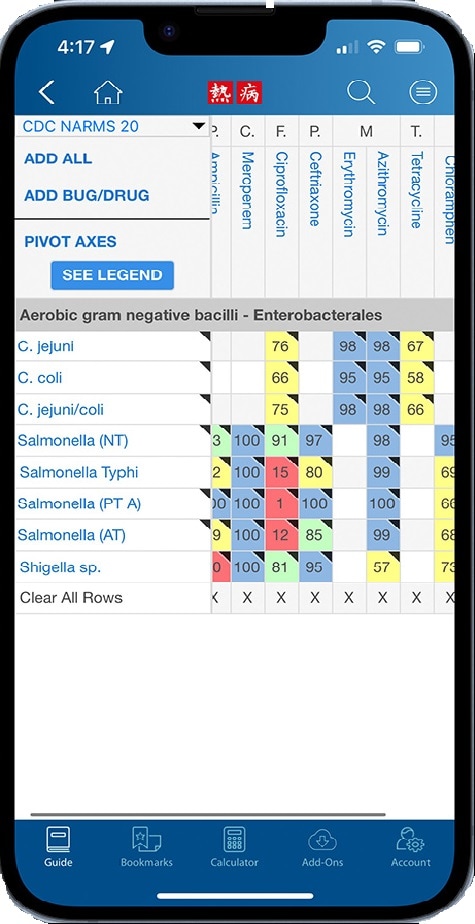Key points
- Most patients with Salmonella diarrheal illness require only supportive care.
- Patients with profuse diarrhea or vomiting should be rehydrated.
- Antibiotic treatment should be considered only for certain patients.
- CDC has additional recommendations for managing patients with known or suspected multidrug-resistant Salmonella Newport infection after travel to or from Mexico.

Overview
Salmonellosis, the illness caused by Salmonella bacteria, primarily results in mild to severe acute gastroenteritis.
Laboratory testing, particularly culture, is recommended for the diagnosis of salmonellosis. With some Salmonella becoming less susceptible to essential antibiotics, antimicrobial susceptibility testing may be necessary.
Most patients with salmonellosis require only supportive care. Antibiotic treatment should be considered only for patients with severe infections and patients at risk for invasive disease.
Clinical features
Symptoms of acute gastroenteritis due to infection with Salmonella can include:
- Sudden onset of diarrhea (which may be bloody or mucoid)
- Abdominal cramps
- Fever usually present
- Nausea, vomiting, and headache may occur, though less frequent
Diarrhea may last for several days and lead to potentially severe dehydration, especially young children and older adults.
Even after clinical symptoms are no longer obvious, Salmonella may be found in stool for several weeks.
Diarrhea lasting more than 7 days
Most people recover completely within a week, although it may be several months before their bowel habits are entirely normal. Less commonly, patients might have diarrhea lasting weeks or months or have periods of relief followed by relapse.
Extra-intestinal infection
Sometimes, Salmonella infection spreads to urine, blood, bones, or other internal organs, causing symptoms related to that body part or system. Some of these extra-intestinal infections can have long-term effects, depending on which part of the body is infected.
Invasive infections (those occurring in a normally sterile body site:
- Occur in about 8 percent of persons with laboratory-confirmed Salmonella infection
- Most commonly occur among young children, older adults, and people with a compromised immune system
- Can be severe and potentially life-threatening
- May occur as
- Bacteremia (infection of the blood)
- Meningitis (infection of the membranes lining the brain and spinal cord)
- Osteomyelitis (infection of the bone)
- Septic arthritis (infection of a joint)
- Bacteremia (infection of the blood)
Reactive arthritis
Some people with Salmonella infection develop pain in their joints called reactive arthritis. This condition can last for months or years and can lead to chronic arthritis. People with reactive arthritis may also have irritated eyes and pain while urinating. Reactive arthritis following a Salmonella infection is most common among people who are 15–35 years.
Diagnosis
Salmonellosis should be considered in the differential diagnosis of patients with acute diarrhea, particularly if fever is present or the patient traveled internationally before becoming ill.
Laboratory testing is necessary to confirm a diagnosis of salmonellosis, and is recommended when salmonellosis is suspected, especially if antibiotic treatment will be prescribed.
- Culture (e.g., stool, urine, blood) is the gold standard for diagnosis. Resulting isolates can provide additional information used for patient care (such as virulence and antimicrobial resistance) and public health practice (such as outbreak identification).
- If Salmonella is identified by a PCR multiplex panel or other culture-independent diagnostic test (CIDT), follow-up (reflex) culture is recommended to obtain an isolate for antimicrobial susceptibility testing.
- Serologic testing is unreliable and not advised.
- If Salmonella is identified by a PCR multiplex panel or other culture-independent diagnostic test (CIDT), follow-up (reflex) culture is recommended to obtain an isolate for antimicrobial susceptibility testing.
- Antimicrobial susceptibility testing is recommended to guide the choice of antibiotic if antibiotic treatment is needed.
- Laboratory-confirmed salmonellosis infections are reportable in the United States. Follow guidance from your local or state health department.
Patient management
Who should receive treatment
Most patients need only supportive care.
Most patients with Salmonella diarrheal illness require only supportive care, which includes fluid and electrolyte replacement. In healthy people with Salmonella infection, antibiotics generally do not shorten the duration of diarrhea or fever.
Some patients might need antibiotic treatment.
Antibiotic treatment should be considered only for certain patients, such as
- People with severe diarrhea, blood infection, or extra-intestinal infections (for example, urinary tract infection), and
- People at risk for invasive disease, such as
- Infants
- People who are 50 years and older with atherosclerosis
- People with immunosuppression, heart disease, or major joint disease
- Infants
The main risks of antibiotic treatment include adverse effects of the antibiotic, the possibility of prolonged asymptomatic Salmonella carriage*, and disturbance of the microbiome. Antibiotic use also contributes to antimicrobial resistance.
*Prolonged carriage can result in patients in high-risk occupations in some jurisdictions being kept out of work for an extended period. Prolonged carriage also increases the risk of secondary infections, such as infection among family members.
Treatment recommendations
- Limit use of antibiotics for patients with an acute diarrheal illness to those with clinical indications.
- Recommended first-line antibiotics include fluoroquinolones, azithromycin, and third-generation cephalosporins.
- Follow-up stool culture may be needed with prolonged diarrhea.
Management of multidrug-resistant Salmonella Newport infections
CDC has observed an increase in multidrug-resistant Salmonella Newport infections among travelers to and from Mexico. Guidance for diagnosing and treating patients known or suspected to have an infection with this strain of Salmonella is available.
Patient counseling
People with salmonellosis should:
- Wash their hands thoroughly with soap and water for at least 20 seconds during key times, including after using the toilet
- Not share their food with others
- Not handle, prepare, or serve food to others
- Stay home from childcare, school, and work while sick or until the health department says it is safe to return
- Not swim or soak in shared bodies of water – including in pools, hot tubs, lakes, ponds, or the ocean – until they have fully recovered
- Wait to have sex until they have fully recovered
- Be extra diligent about practicing good hygiene for at least 2 weeks after diarrhea ends; people with salmonellosis (and some other diarrheal illnesses) might continue to shed the bacteria in stool after symptoms resolve
Travelers should:
- Always practice safe food and drinking habits.
- These habits can help protect travelers against other travel-associated illnesses, including travelers' diarrhea and typhoid fever and paratyphoid fever.
- These habits can help protect travelers against other travel-associated illnesses, including travelers' diarrhea and typhoid fever and paratyphoid fever.
- Be vaccinated against typhoid fever at least two weeks before going to a place where an outbreak is occurring, or the disease is endemic.
- Visit CDC's Travelers' Health website for additional guidance regarding their travel destination(s).
Antimicrobial Resistance
Some Salmonella are becoming less susceptible to essential antibiotics, jeopardizing options to treat severe infections.
CDC tracks resistant infections through the National Antimicrobial Resistance Monitoring System (NARMS). The NARMS program at CDC helps protect public health by providing information about emerging bacterial resistance, the ways in which resistance is spread, and how resistant infections differ from susceptible infections.
Sanford Guide

Sanford Guide has converted antimicrobial resistance data from CDC into user-friendly antibiograms that are available to all users of the Sanford Guide mobile app, and to subscribers of Sanford Guide's Web Edition.
Data in Sanford Guide are from the National Antimicrobial Resistance Monitoring System (NARMS) and also are available through CDC's data tool NARMS Now.
Selected publications
Resources
- CDC Yellow Book
- Travel-related Infectious Diseases: Salmonella
- Preparing International Travelers: Food & Water Precautions
- Travel-related Infectious Diseases: Salmonella
- Travelers' Health Clinician Information Center | CDC
- Clinical practice guidelines for the diagnosis and management of infectious diarrhea | Infectious Diseases Society of America, 2017
- Red Book: Salmonella Infections | American Academy of Pediatrics
- Podcast: Treatment Options for Salmonella Infection | Consultant 360
